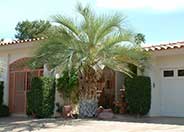
Common name:Pindo or Jelly Palm, Yatay
Botanical name:Butia capitata
This slow-growing tree has leaves that vary from bluish gray to green and has round, yellow to orange fruit that is edible and delicious. Arching leaves spread 10'-15' wide; palm can reach 20' tall.
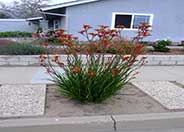
Common name:Red Cross Kangaroo Paws
Botanical name:Anigozanthos 'Red Cross'
Red Cross Kangaroo Paws has spectacular, tall (4'-5'), multi- branched stems with rich burgundy coloration on both flowers and stems. The flowers open to reveal a green interior. It is a good strong grower with very dark red flowers.- San Marcos Growers
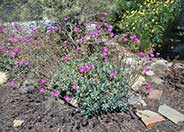
Common name:Rock Purslane
Botanical name:Cistanthe grandiflora 'Jazz Time'
This perennial will grow 12"-36" and produces large blue-green rosettes that last for a long season. It produces large, silky, lavender pink flowers that have lime-green, purple spotted calyces.
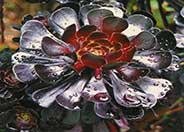
Common name:Aeonium
Botanical name:Aeonium arboreum 'Zwartkop'
Aeonium arboreum 'Zwartkop' is a succulent perennial that is used for accenting effect. Aeonium arboreum grows 3 ft. tall and wide. Each branch has a 6-8 in. wide rosette of dark green, fleshy leaves.The flowers are yellow in clusters. The flowers are yellow in clusters.
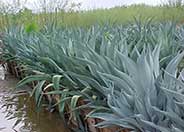
Common name:Smooth-edged Agave
Botanical name:Agave weberi
This is a striking medium-sized agave that can grow to 5' tall by 6-10' wide. This agave has very fine marginal teeth, and is sometimes spineless. Supplemental summer watering can prevent yellowing from heat stress in the summer. These plants are also moderately cold hardy, tolerant of temperatures down to 12f. More refined looking than americana. Prone to weevils. Native in Eastern central Mexico. One of the largest of the Agaves.-Mountain States Nursery
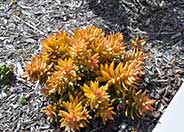
Common name:Orange Sedum
Botanical name:Sedum nussbaumeranian
This succulent perennial will grow best in a wall pot or hanging basket due to its long stems. It has light, gray green leaves that grow over one another to give off a "braided" look. The flowers are pink to deep red and bloom in spring and summer.
Designer: Laura Dalton
Photographer: GardenSoft
Incorporate compost 6" into your soil to retain water, reduce compaction, feed earthworms, and provide valuable nutrients to your plants.
Attract, or buy beneficial insects such as ladybugs and lacewings to control pest outbreaks in your garden.